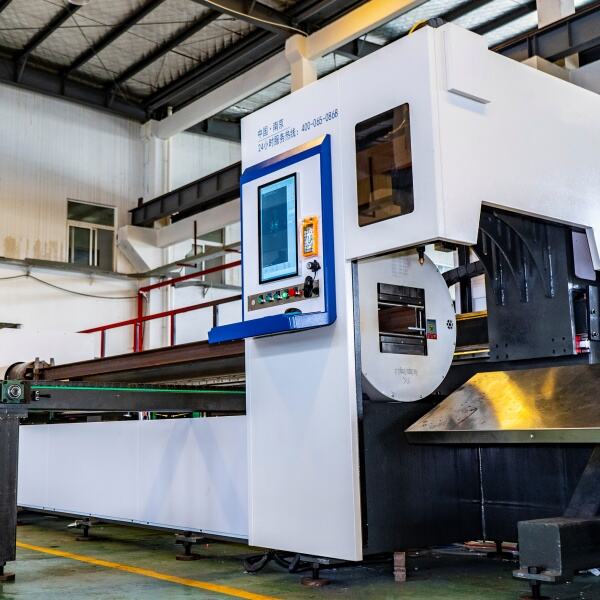Fremtiden for metalbearbejdning: Innovationer inden for fiberlaser skæremaskiner
Introduktion til fiberlasermaskiner til skæring
Når industrier verden over udvikles, bliver fiberlasermaskiner til skæring afgørende i metalbehandling. Men hvad er de egentlig?
Hvad er Fiberlaser Skæring?
Fiberlaserskæring refererer til en metode, der anvender en fiber-optisk laser til at skære gennem forskellige materialer med høj præcision og hastighed. Denne innovative teknologi har fået stor udbredelse i mange sektorer på grund af sin effektivitet i forhold til traditionelle metoder.
Sådan fungerer fiberlasere
Fiberlasere genererer kraftfulde stråler gennem fiberkabler fremstillet af glas. Disse maskiner leder lys gennem en laserresonator, som forstærker strålens intensitet. Når den fokuseres på et materiale, kan den producerede energi effektivt fordampe eller smelte underlaget, hvilket gør den egnet til detaljerede designs.
Fordele i forhold til traditionelle skæremetoder
Fiberlasere overgår traditionelle CO2-lasere på mange områder, især hvad angår effektivitet, hastighed og omkostninger. De forbruger mindre energi og giver samtidig skarpere snit med minimal varmefortæring. Dette fører til lavere driftsomkostninger og mindre affald, hvilket gør dem til en meget attraktiv investering inden for moderne produktion.
Nuværende tendenser inden for fiberlaser-skæretøjsteknologi
Fiberlaserteknologiområdet blomstrer, drevet af innovationer, der forbedrer dets anvendelse.
Stigende præcision og kvalitet
Der har været en stigning i efterspørgslen efter mere præcise snit og komplekse designs. Fiberydelser imødekommer dette behov og giver overlegent kantkvalitet og glattere overflader sammenlignet med konventionelle udstyr. Forbedret præcision reducerer behovet for sekundære operationer, såsom afslutning.
Fremsteg i skærehastighed og effekt
Kontinuerlige forbedringer i fiberlasersystemer tillader hurtigere skæretider uden at kompromittere kvaliteten. I øjeblikket integrerer producenter højere effektniveauer, hvilket øger materialetykkelseskapsler og skalerer produktionsvolumen uden forsinkelse.
## Integration med Industri 4.0
Opkomsten af Industry 4.0 har indledt en æra med forbindelse, hvor maskiner kommunikerer med hinanden via IoT-teknologier. Denne integration fremmer realtidsmonitorering og forudsigende vedligeholdelse, hvilket giver producenter mulighed for at maksimere effektiviteten og reducere driftsstop.
Innovationer der driver fremtiden for fiberlaserskæring
Flere innovationer former landskabet for fiberlaserskæremaskiner med lovende perspektiver.
Rollen af Automatisering
Automatisering i fiberlaserskæring giver producenterne hidtil usete effektiviteter. Ved at minimere manuelt arbejde gennem automatiseret indlæsning, aflæsning og justeringer kan virksomheder opnå uafbrudt drift. Denne tendens transformerer grundlæggende produktionsprocesser.
Bæredygtighed og miljøvenlige metoder
Industrien adopterer i stigende grad grønne initiativer, og fiberydretsteknologi passer perfekt ind i denne bevægelse. Med fremskridt som miljøvenlige skæregasser og energieffektiv drift hjælper disse maskiner ikke kun med at reducere omkostninger, men også med at opfylde miljømæssige ansvarsforpligtelser.
Kunstig intelligens i laserudskæring
Implementering af kunstig intelligens og maskinlæring i fiberydretssystemer baner vejen for forbedret effektivitet. KI optimerer skæreparametre, forudsiger vedligeholdelsesproblemer før de opstår og analyserer driftsdata for at forbedre maskinydelsen.
Fremtidens markedsvækst og potentielle anvendelser
Markedet for fiberydreudskæring viser stor potentiale, især med dets ekspanderende anvendelser.
Nye industrier, der anvender fiberydreudskæring
Fra automobilindustrien til luftfartssektoren udnytter nye industrier fiberlaserteknologi til mange forskellige anvendelser. Denne fleksibilitet giver producenterne mulighed for at tilpasse deres operationer og fremstille specialiserede komponenter, der imødekommer specifikke industrineedsættelser.
Tilpasning og fleksibel produktion
Når kundernes krav ændrer sig mod mere personlig tilpasning, tilbyder fiberlaser til skæring hidtil usete muligheder for individualisering. Evnen til hurtigt at ændre designs og bearbejde forskellige materialer placerer producenterne fordelagtigt i den høst konkurrencedygtige markedssituation.
Påvirkning af produktionslandskabet
Skærebåren af fiberlasermaskiner på produktionslandskabet er dyb; den effektiviserer processer og forbedrer produktkvaliteten. Når industrierne fortsætter med at adoptere denne teknologi, vil det konkurrenceprægede landskab uundgåeligt ændre sig.
Konklusion: Udsigter for fiberlaserskæring i fremtiden
Nøglepunkter
Kort fortalt præsenterer udviklingen inden for fiberlaser-skæretøjsteknologi mange fordele, fra overlegen præcision i skæring til dets bæredygtighedsattributter. Når automatisering og kunstig intelligens vinder frem, kan virksomheder se frem til fremskridt, der yderligere optimerer drift.
Forudsigelser for fremtidige udviklinger
Fremtiden rummer stor potentiale for fiberlaserskæremaskiner. Vi forventer at se forbedret effektivitet, mere intelligent integration af AI og vedvarende fremskridt inden for bæredygtighed. Når disse tendenser bliver til virkelighed, vil branchen sandsynligvis opleve hidtil uset vækst og innovation.
Afslutningsvis er fiberlaser skæring ikke bare et fremstillingsværktøj; det er en katalysator for fremtiden for produktion, der lover effektivitet, bæredygtighed og præcision. At holde sig ajour med disse innovationer vil placere producenterne til langsigtet succes i et konstant udviklende landskab.



